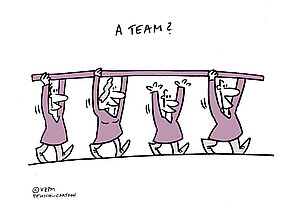Teamwork
Definition
Teamwork is about bringing people together to realise a common objective.
Teams are groups of people working together to realise specific objectives. Project teams are commonly multi-disciplinary; specialists in different disciplines work together to realise complex outcomes. Teamwork is about building a productive team by forming, supporting and leading the team. Team communication and team relationships are among the most important aspects of successful teamwork.
Purpose
The purpose of this competence element is to enable the individual to select the right team members, promote a team orientation and effectively manage a team.
Description
Teamwork covers the complete lifecycle of teams. It starts with the initial phase of selecting the right team members. After that, the team has to be built, supported and steered. During the various phases of the project, as the team members and the team as a whole acquire more maturity in their respective tasks, they can perform these tasks more independently and consequently are given more responsibility.
Team building is often done by the use of meetings, workshops and seminars that may include the individual leading the project, team members and sometimes other interested parties. Team spirit (i.e. getting people to work well together) can be achieved through individual motivation, team goal setting, social events, supporting strategies and other methods.
Problems may arise due to technical or economic difficulties or other kinds of stressful situations. Issues may also arise due to cultural and educational differences, different interests and/or ways of working, or members being located great distances apart. The individual leading the team needs to continually develop the team and its members throughout the lifecycle of the project. During their time working for the project, the performance of team members should be regularly reviewed by the individual leading the team in consultation with the line manager, to assess and respond to development, coaching and training needs. Where the performance of a team member is below the required standard, remedial action may be necessary.
Throughout the life of a team, personal involvement should be encouraged, networking stimulated, a productive work environment facilitated and communication and relationships supported.
Key competence indicators
Select and build the team
To ensure successful teamwork, the right resources for the team have to be selected. Apart from ensuring that they have the necessary knowledge and skills, the individual leading the team also has to take care that the selected team members have the right ‘chemistry’ to be able to work together as a team. Before the chosen team can start performing, the individuals have to generate an understanding of themselves as a team. The role of the individual leading the team is to translate individual motivation into team performance. The members have to be enabled to learn about each other and the tasks they are facing. Team building is a continuous task, but as the team matures the necessary activities for the individual leading the team change accordingly.
Measures
- Considers individual competences, strengths, weaknesses and motivation when deciding on team inclusion, roles and tasks
- Clarifies objectives and creates a common vision
- Sets the team objectives, agenda and completion criteria
- Negotiates common team norms and rules
- Motivates individuals and builds team awareness
Promote cooperation and networking between team members
Stimulating cooperation means actively influencing team participants to work together and contribute with their experience, knowledge, opinions, ideas and concerns, for the sake of the agreed objectives. Discussions and disagreements are an unavoidable consequence of this, but as long as the individual leading the team makes sure that a productive and respectful atmosphere is maintained, team members can expect that conflict will lead to better performance. Whenever individual team members set out to disrupt cooperation by playing a divisive or counter-productive role, the individual leading the team needs to address this by correcting and, in extreme cases, replacing the team member. The team leader can stimulate networking through physical and virtual activities where team members share their knowledge and motivate and inspire each other.
Measures
- Creates opportunities for team member discussions
- Asks for opinions, suggestions and concerns from team members in order to improve performance
- Shares successes with the team(s)
- Promotes cooperation with people both within and outside the team
- Takes appropriate action when team cooperation is threatened
- Uses tools for collaboration
Support, facilitate and review the development of the team and its members
Team development involves continuously developing the team, encouraging members to gain new knowledge and skills. The role of the individual leading the team is to support, enable and review these learning efforts as well as creating opportunities to share knowledge between team members, other teams and the organisation outside the project.
Measures
- Promotes continuous learning and knowledge sharing
- Uses techniques to engage in development e.g. on-the-job training
- Provides opportunities for seminars and workshops (on- and off-the-job)
- Plans and promotes ‘lessons learned’ sessions
- Provides time and opportunity for self-development of team members
Empower teams by delegating tasks and responsibilities
Responsibility creates involvement. The individual leading the team increases involvement – and individual and collective empowerment – by delegating tasks and problems to teams or team members. Dependent on their team maturity, delegated tasks can be big, challenging and important. The output of delegated tasks to individuals and teams should be measured, with feedback cycles for the team to ensure learning occurs.
Measures
- Delegates tasks when and where appropriate
- Empowers people and teams by delegating responsibility
- Clarifies performance criteria and expectations
- Provides reporting structures at team level
- Provides individual and team feedback sessions
Recognise errors to facilitate learning from mistakes
The individual leading the team makes sure that the effect of errors and mistakes on the outcomes, processes and success of the project are kept to a minimum. The individual is aware that mistakes can always happen and understands and accepts that people make errors. The individual analyses mistakes and facilitates learning from mistakes. Errors and mistakes are used as a platform for change and improvement so that there is less chance of future errors.
In some cases, the individual leading the team can even promote behaviour that increases the chance of errors, if the project needs innovative ways to overcome problems and difficulties. Even then, the individual leading the team ensures that the final outcomes, processes and project success are not affected negatively. The individual seeks root causes for mistakes and takes effective action to ensure that the same mistakes do not occur again.
Measures
- As far as possible, avoids negative effects of errors on project success
- Realises that mistakes happen and accept that people make errors
- Shows tolerance for mistakes
- Analyses and discusses mistakes to determine improvements in processes
- Helps team members to learn from their mistakes


